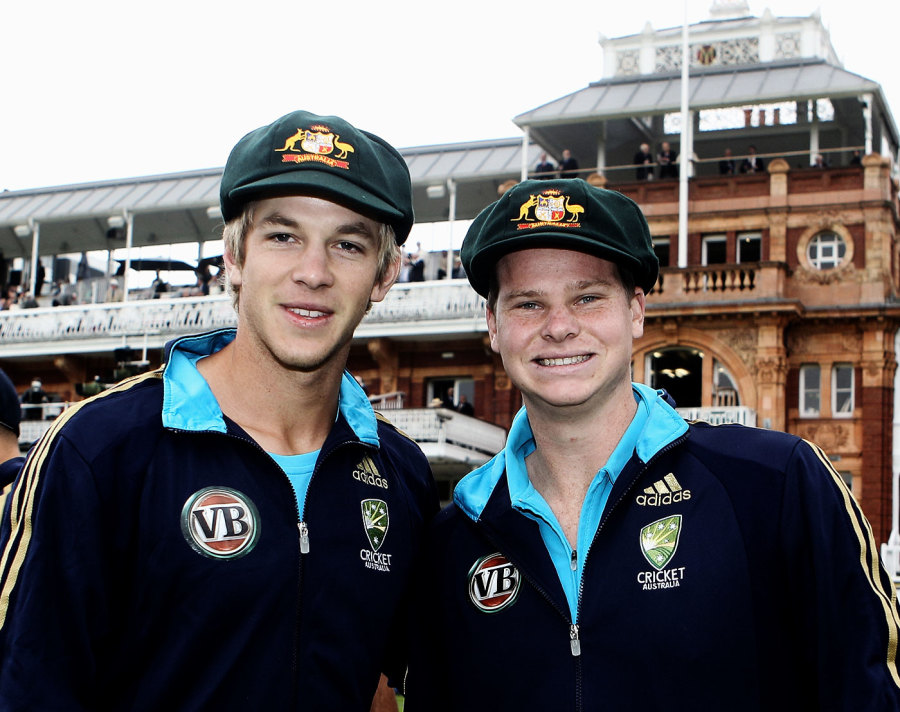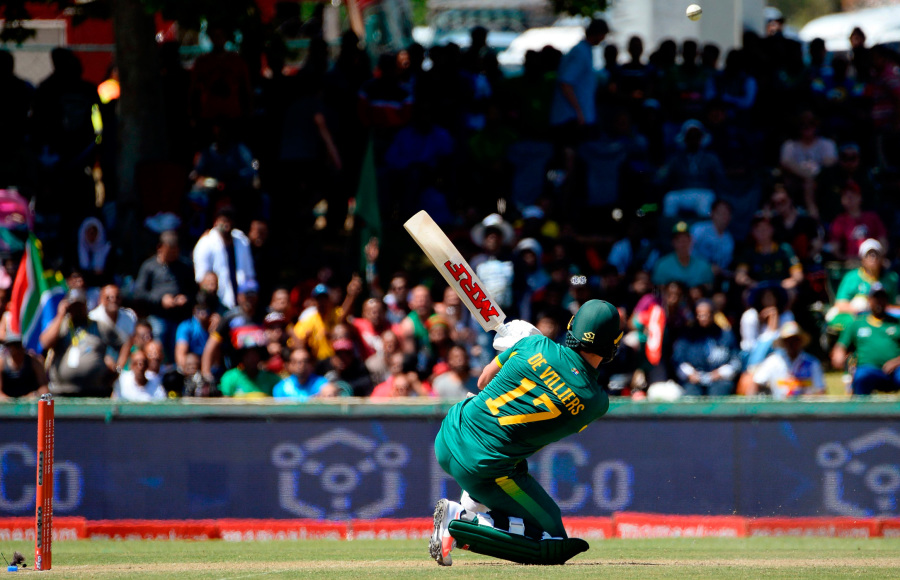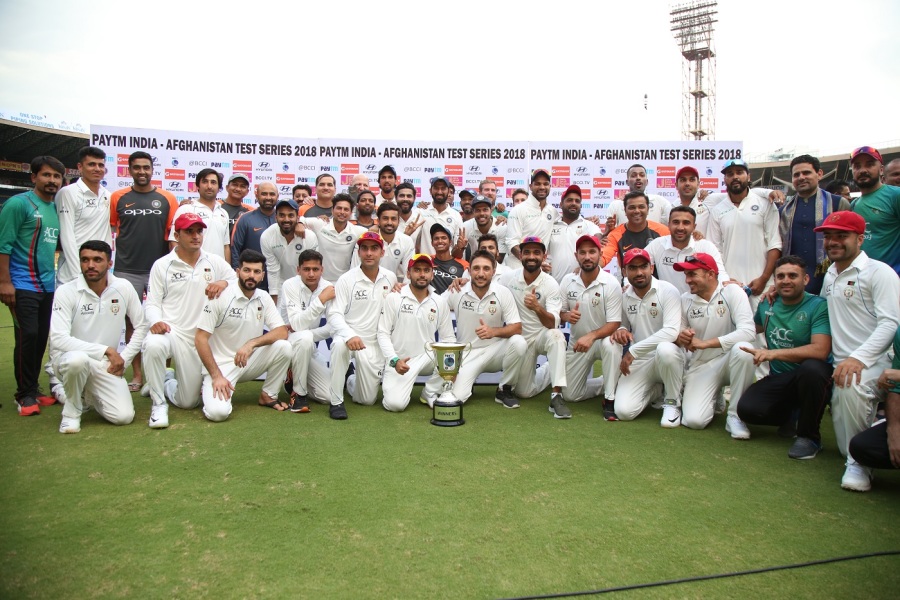India's dream year, Australia's drama, and Afghanistan's welcome to the big time

India
by Sidharth Monga
Begin the year as the No. 1 Test team and end that way. Win half your Tests despite playing predominantly away. Win a first ODI series in South Africa and also the Asia Cup. Win a T20 tournament and a series in England. Maintain a win-loss ratio of 3.5 in both limited-overs formats. Lose almost nothing in any format at home. End the year with a great chance to win your first series in Australia. This is the stuff dream years are made of, but 2018 will equally be defined by the missed opportunities and the what-ifs. What if they had selected better? What if they had won more tosses? When next will they go to these countries with such a strong team? As a professional sportsperson, though, you can't dwell on what-ifs, which is what this Indian team has done well to avoid. The future holds promise. A great first week of January could give them a series win in Australia, and then, of course, comes the World Cup.
High point
The win in the Johannesburg Test on a pitch tailor-made for the hosts, where India decided to bat first on a tough pitch and then badgered the South African batsmen with their pace battery.
Low point
The series defeats in England and South Africa, despite travelling with a strong side. We will never know if they would have won had they done the little things better.
Results
Tests: P14 W7 L7
ODIs: P20 W14 L4 T2
T20Is: P19 W14 L4 NR1

Australia
by Daniel Brettig
They say the darkest hour is right before the dawn. Things could scarcely have got darker for Australian cricket in South Africa and after it, when an Ashes-winning team fell apart on the field and in the dressing room while cheating in the name of a win-at-all-costs culture that had grown out of control over several years.
Years of discontent about the national team's behaviour combusted with Newlands, to leave the game in Australia at a low point, summed up by Steven Smith's tears upon being banned for a year.
That was followed by numerous other departures, and moments of introspection - not least the release of the Longstaff and McCosker culture reviews, which brought on the end of David Peever's fractious term as chairman. A A$1.18 billion broadcast deal with Fox and Seven was signed in April. Justin Langer became coach on a four-year contract in May. Aaron Finch was appointed to the white-ball captaincy alongside Tim Paine, who had been appointed to replace Smith as Test leader before the Cape Town Test was even over.
Gradually results began to improve. A heavy ODI series defeat in England was followed by a better showing in the triangular series in Zimbabwe, and a meritorious draw against Pakistan in Dubai that was only soured by the loss of the following Test from a winning position. At home, India were run as close as 31 runs in Adelaide, before a comprehensive victory was achieved on a flier of a pitch at the new Perth Stadium. When that was followed by defeat in Melbourne, dawn still seemed some way from breaking.
High point
Discovering the meaning of hard cricket while watching Usman Khawaja and Paine conjure a great escape from what seemed certain defeat to Pakistan in Dubai. In trying to become a winning team again, the Australians know it is critical that they first become hard to beat.
Low point
Premeditated cheating to try to recover a match and series fast slipping away in Cape Town, followed by lies and cover-ups that cost Smith, David Warner and Cameron Bancroft their places in the team, Darren Lehmann his coaching job, and a host of further departures at Cricket Australia via the cultural reviews that followed.
Results
Tests: P10 W3 L6 D5
ODIs: P13 W2 L11
T20Is: P19 W10 L8 NR1

South Africa
by Liam Brickhill
Home was a Test fortress for South Africa in 2018. Virat Kohli's India were beaten 2-1 and Australia thrashed 3-1 (including by a mammoth 492 runs in Johannesburg, the biggest Test win in terms of runs by any team since 1934. But there were continued signs of fragility abroad. South Africa waved the white flag in Sri Lanka with a 2-0 defeat. In ODIs, the 5-1 debacle against India was followed by series wins over Sri Lanka, Zimbabwe and Australia, and real progress was made in the format in the first full year of Ottis Gibson's tenure as coach.
More broadly, South Africa's eyes were cast towards the future in 2018. By mid-year they were without the mastery of AB de Villiers, whose retirement in May forced the move to find his successor. South Africa also bade farewell to Morne Morkel this year, and while Faf du Plessis, Hashim Amla, JP Duminy, Imran Tahir and Dale Steyn are all part of plans for the World Cup, they are also in their twilight. Vernon Philander won't be too far behind them. As a result, this was also the year that South Africa began to gain a clearer view of the players who will become central in the future. Quinton de Kock is already established, as is Kagiso Rabada, while Lungi Ngidi burst onto the scene with 6 for 39 against India in Centurion, Aiden Markram progressed quickly enough to be trialled as a captain, and Duanne Olivier broke through with a standout 11-wicket performance in the thrashing of Pakistan at the end of the year. As much as 2019 will be about the swansongs of senior players, and the World Cup, it will also be the year that South Africa move into a new era with the fresh crop.
ALSO READ: How England, Pakistan, New Zealand, Bangladesh, Zimbabwe and Ireland did in 2018
High point
South Africa set several records during their 40-run win over Australia in Hobart: David Miller and Faf du Plessis added 252 for the fourth wicket - the highest ODI stand in Australia-South Africa contests. It was also South Africa's first 300-plus total against Australia down under. The bowlers sealed the win and South Africa's second bilateral series victory in Australia.
Low point
It was quite clear just how much work was needed to put Vision 2019 into place when South Africa crashed to a series defeat against India, culminating in the eight-wicket thrashing in Centurion - hardly a fitting end for de Villiers' last ODI, and South Africa ended up little better than net bowlers as Virat Kohli stormed to his 35th ODI ton.
Results
Tests: P10 W6 L4
ODIs: P17 W9 L8
T20Is: P7 W4 L3

West Indies
by Nagraj Gollapudi
The cricket world held its breath when Afghanistan beat West Indies in the Super Sixes of the World Cup Qualifiers. Jason Holder's men had won all four of their group matches, but that would count for nothing if they did not win the remaining two Super Sixes games. Holder played the leading hand as West Indies secured the wins to make the ten-team World Cup.
On the Test front, West Indies failed to carry forward the promise displayed on the back of the win at Headingley in 2017. They secured just three Test victories - winning the home series against Bangladesh 2-0, and the win that levelled the series against Sri Lanka. Holder and Shannon Gabriel were the two best performers, but none of the West Indies players finished in the top bracket in any of the three formats on the international batting and bowling charts.
High point
Qualifying for the 2019 World Cup was a total team effort, with Holder, Kemar Roach, Marlon Samuels, Shimron Hetmyer, Chris Gayle and Rovman Povell producing standout performances.
Low point
West Indies lost 2-0 in the away Test series in Bangladesh, including being asked to follow-on in the second Test, where only one of their batsman crossed the 50 mark across both innings.
Results
Tests: P9 W3 L5
ODI: P18 W8 L9 T1
T20: P15 W4 L10 NR 1

Women
by Annesha Ghosh
With T20I rankings introduced and international status awarded to all T20s among member nations, the year of the first standalone women's World T20 made good on its promise of fireworks across formats.
New Zealand smashed the highest total in men's or women's ODIs; teenager Amelia Kerr broke Belinda Clark's 21-year world-record score; underdogs Bangladesh dethroned India as Asia Cup champions; and England piled on the highest WT20I total hours after New Zealand had set the record at the same venue.
There were groundbreaking firsts: the star-studded one-off women's T20 exhibition match, and Alex Blackwell becoming the first woman to be elected to the New South Wales cricket board in 159 years. On the other hand, FICA, the international players' association, highlighted how "amateurish" domestic structures are hindering the growth of women's cricket.
There were also some high-profile retirements. Blackwell quit the international game, Jhulan Goswami T20Is, and four pioneers of Ireland's women's cricket - Isobel and Cecilia Joyce and Clare Shillington and Ciara Metcalfe - bowed out of the game less than a month before the first professional contracts were announced for Ireland women.
India's players too came in for greater financial security, their top cricketers earning a 233% pay hike. Pakistan's centrally contracted players went sans pay for more than six months.
High point
The "hurt" of two successive world-tournament exits spurred Australia to revisit their values, which resulted in limited-overs series wins in India and a record fourth World T20 title.
Low point
Uncomplimentary tweets, leaked emails, and discord over the reappointment of coach Ramesh Powar ballooned into a soap opera, set off by Mithali Raj's controversial omission from India's World T20 semi-final loss.

Afghanistan
by Peter Della Penna
Afghanistan's rise up the limited-overs pecking order continued in 2018, propelled by a triumvirate of world-class spinners. The country's latest teenage mystery spin sensation, Mujeeb ur Rahman, proved he was worth Kings XI Punjab's US$563,000 bid at the IPL auction by taking a joint-tournament best of 17 wickets at the World Cup Qualifier in Zimbabwe as Afghanistan clawed back from three straight losses at the start of the event to secure a spot at the 2019 World Cup.
They showed their mettle in the Asia Cup too, beating Sri Lanka and Bangladesh. Final-over losses in the Super Fours to Pakistan and Bangladesh were seen as disappointing results, showing how far Afghanistan have come. After India steamrolled them by an innings inside of two days in their maiden Test in June, Afghanistan held them to a thrilling tie in the Asia Cup, a promising end to the year.
High point
Captain Asghar Afghan's inspirational 39 not out, just weeks after an emergency appendectomy on the eve of the Qualifier, helped Afghanistan past Ireland and into the World Cup.
Low point
Having dominated the Intercontinental Cup first-class tournament for Associates, the shellacking Afghanistan received from India in their maiden Test showed they have plenty to learn.
Results
Tests: P1 L1
ODIs: P20 W12 L7 T1
T20Is: P7 W7 L0
Sri Lanka
Andrew Fidel Fernando
At least it wasn't quite as pitiful as 2017 had been. After two years in which expectations were lowered, and what passed as acceptable for Sri Lankan cricket was redefined, the modest peaks in 2018 almost represented progress, particularly in the Test format.There was a Test series win in Bangladesh to begin with, a thrilling victory in the final Test to draw a series in the Caribbean (Sri Lanka had previously won only one Test in the islands), and the home shellacking of South Africa. In ODIs, Sri Lanka had also won a tri-series featuring Bangladesh and Zimbabwe, a feat that appeared unlikely when that tournament began.

But let's not get carried away. Amid the occasional patches of joy and calm, there has been a dumped-and-seething limited-overs captain, a galling home Test whitewash and, worst of all, the gathering gloom of fixing, with Sanath Jayasuriya, Nuwan Zoysa and Dilhara Lokuhettige charged as part of what the ICC suggests is a much larger investigation. Although there are the makings of a half-decent Test team now, Sri Lanka are as weak at limited-overs cricket as they have been in decades. Their outlook for the World Cup is bleak.
High point
South Africa had won in Sri Lanka in 2014, but Sri Lanka got their batting and their spin bowling to work in sync to crush them 2-0 in July.
Low point
Sri Lanka had hoped England would also be easy prey. Instead, it was they who found themselves chased down, tackled, and torn apart, during the course of a three-Test series in which England seemed to have better understanding of Sri Lankan conditions than the hosts themselves.
Results
Tests: P12 W4 L5 D3
ODIs: P17 W6 L10 NR 1
T20Is: P8 W4 L 4
ALSO READ: How England, Pakistan, New Zealand, Bangladesh, Zimbabwe and Ireland did in 2018

